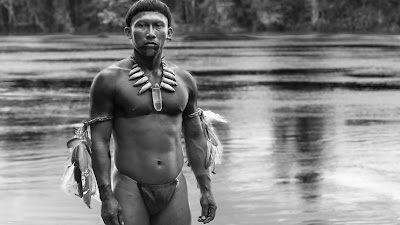Colombian writer and director, Ciro Guerra, took on quit the delicate task when he decided he wanted to greater examine the unheard stories of the many tribes of the Amazon river, in his film Embrace the Serpent. Exploited, oppressed, and mistreated the indigenous people of the Amazon have suffered. But therein lays a piece of this fragile double edged sword, to depict them as “suffering” people, that is all they come to be, inferior to colonial society. Similar to how history books falsely depict Native Americans as past “problem” for the European manifest destiny that involved the conquering of the west. A “problem” that has since be “resolved” and taken care of, neglecting the many tribes that still live on today who struggle have their voices heard because we misconceive them to be dead.
Guerra wants the muted voice of the indigenous people of the Amazon to be heard but more importantly he refuses to misrepresent them. He obviously wants the film to play with ethnological realism but doesn't really have the liberty to do so respectfully as a work of nonfiction. In order to compensate Guerra creates fictional names for tribes, plants, and places in order to maintain respect, he states “I would have had to spend forty years with a single community to accurately represent an indigenous group.” He is extremely mature to say so and creatives should follow suit when engaging the lives of such indigenous tribes. Although Guera wanted to tell the story of indigenous people of the Amazon he knew in order to reach a wide audience he had to bring a Eurocentric perspective to the film.
The stories of explorers Theo and Evan are separated by over forty years but are connected by by the Shaman Karamakate. Gurra entwines their two separate characters as they embrace the serpent that is the Amazon river. They seem to be the “same person” (just like Karamakate says) as match cuts of the river are used to jump in between forty years of time. The mirroring effect of the characters Theo and Evan create for one larger character arc begins a with a man of Western society and ends with one of the serpent.
As the aesthetic identity of the film is quite beautiful, the narrative of the film is a bit uglier. Not in a sense of storytelling technique as Ciro Guerra constructed a truly engaging script, the problem is the film engages viewers in a way they are not comfortable with. The issues that Guerra confronts are not talked about outside the context of the film for a reason. The questions Guerra formulates in the film don't have any easy answer for a reason. The material is ugly, emotionally heavy, and morally complex. Which are best reasons to make a film and the reason Embrace the Serpent needs to be seen.


No comments:
Post a Comment